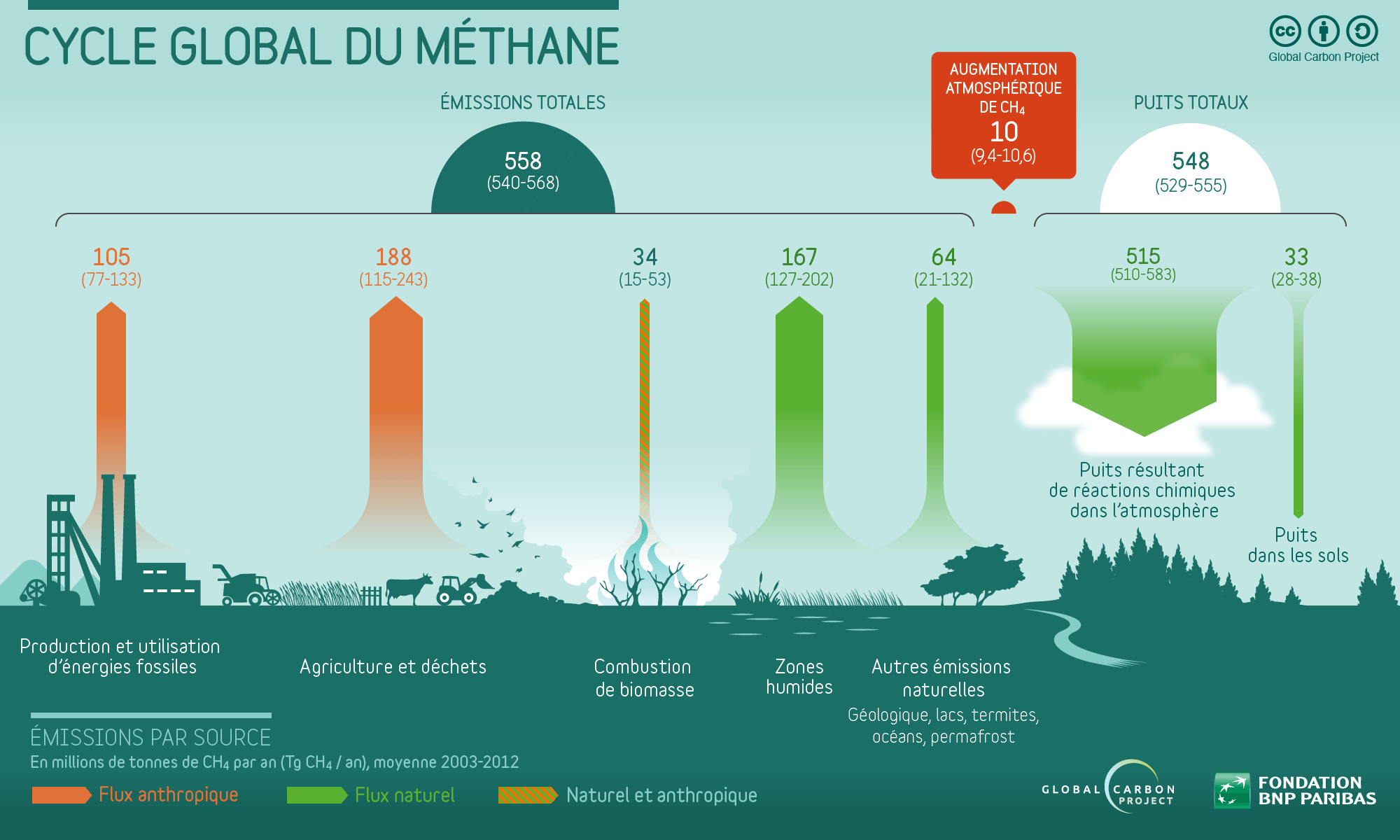Data sources:
Saunois et al. 2020 The Global Methane Budget 2000-2017. Earth System Science Data.
Jackson et al. 2020 Increasing anthropogenic methane emissions arise equally from agricultural and fossil fuel sources. Environ. Res. Letters.
Importance:
CH4 is a potent greenhouse gas that contributes to human-induced climate change. Atmospheric CH4 concentrations have increased by 150% since the Industrial Era [IPCC, 2013] and have been increasing again since 2007 after almost a decade of stable concentrations in the late 1990s. Understanding the dynamics of the global CH4 budget and attributing changes to different sources is fundamental for tracking climate change and mitigation options to avert further global warming.
The methane budget:
The methane budget as described here, refers to the budget of all emissions and removals of CH4. Unlike for carbon dioxide for which only half of human emissions are removed by uptake in natural reservoirs, for CH4, about 97% of annual emissions are offset by removals within the atmosphere from reaction with OH radicals. Thus, the growth rate of CH4 is the subtle imbalance between emissions and a huge natural sink from OH.
Methane sources include human-induced emissions from Agriculture & Waste (e.g. livestock and rice paddies) and Fossil fuel production & use (coal, gas/oil extraction), which account for about 60% of total emissions. The rest comes from natural emissions, the largest part being due to decomposing organic matter in Wetlands. Biofuel & Biomass burning emissions are both natural and human-induced. Other Natural sources (e.g. geological processes, lakes, rivers, termites) are also important, but these sources are not currently very well understood and their amount are highly uncertain. Those natural sources have existed before the Industrial Era and were in equilibrium with removals by OH. Natural sources are only of concern for future climate change if they are perturbed and increase in response to global environmental drivers. This is the case for wetlands, biomass burning which can increase or decrease in response to shifts in climate and hydrology. The biggest concern and also the biggest unknow is whether the currently small CH4 emissions in the Arctic from small lakes known as thermokarst and permafrost soils will increase in the future as permafrost thaw appears unavoidable in the next decades [Walter Anthony et al. 2016, Gasser et al. 2018].
Estimating the methane budget:
The Global Carbon Project has established a consortium of more than 50 research institutions around the world to gather the observations, statistics and run global models to update and improve the methane budget regularly (every 2-3 years).The CH4 budget is estimated at the global scale, as shown here, but also in 18 continental regions for the 5 source categories listed in bold above using both “top down (TD)” and “bottom up (BU)” methods. BU uses diverse data inventories, observation-driven methods and process-based models (e.g. energy statistics, agricultural data, biogeochemistry modeling). TD optimally combines measurements of atmospheric CH4 at > 100 stations around the world with a first-guess estimate of CH4 emissions into an atmospheric inversion framework.
Following a review of global methane fluxes by [Kirschke et al. 2013] Three decades of global methane sources and sinks published in Nature Geosciences, the first comprehensive synthesis using multiple TD inversions and BU models and inventories, with regional and sectorial details The global methane budget 2000–2012 was published by [Saunois et al. 2016] in Earth System Science Data. A major update The Global Methane Budget 2000-2017 extended to the recent period, is provided by [Saunois et al. 2020] in Earth System Science Data as well.
Uncertainties:
As the number of studies is uneven and generally small, uncertainties are reported in brackets as a range between the minimum and maximum estimates. Uncertainties are typically on the order of 30% of the mean for a given type of CH4 emission at a global scale (less for anthropogenic, more for natural). Uncertainties can increase up to 100% (or more) of the mean when looking at CH4 emission type in a region.
Future work:
As part of its scientific goals, the Global Carbon Project team will further develop more complete and constrained CH4 budgets and provide regular updates. For further information visit the Global Carbon Project (GCP) web page.




